Gypsum
Gypsum is a soft sulfate mineral composed of calcium sulfate dihydrate, with the chemical formula CaSO4·2H2O.[3] It is widely mined and is used as a fertilizer and as the main constituent in many forms of plaster, blackboard/sidewalk chalk, and drywall. A massive fine-grained white or lightly tinted variety of gypsum, called alabaster, has been used for sculpture by many cultures including Ancient Egypt, Mesopotamia, Ancient Rome, the Byzantine Empire, and the Nottingham alabasters of Medieval England. Gypsum also crystallizes as translucent crystals of selenite. It also forms as an evaporite mineral and as a hydration product of anhydrite.
| Gypsum | |
|---|---|
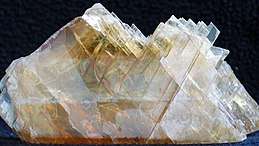 | |
| General | |
| Category | Sulfate minerals |
| Formula (repeating unit) | CaSO4·2H2O |
| Strunz classification | 7.CD.40 |
| Crystal system | Monoclinic |
| Crystal class | Prismatic (2/m) H-M symbol: (2/m) |
| Space group | Monoclinic Space group: I2/a |
| Unit cell | a = 5.679(5), b = 15.202(14) c = 6.522(6) [Å]; β = 118.43°; Z = 4 |
| Identification | |
| Color | Colorless (in transmitted light) to white; often tinged other hues due to impurities; may be yellow, tan, blue, pink, dark brown, reddish brown or gray due to impurities |
| Crystal habit | Massive, flat. Elongated and generally prismatic crystals |
| Twinning | Very common on {110} |
| Cleavage | Perfect on {010}, distinct on {100} |
| Fracture | Conchoidal on {100}, splintery parallel to [001] |
| Tenacity | Flexible, inelastic |
| Mohs scale hardness | 1.5–2 (defining mineral for 2) |
| Luster | Vitreous to silky, pearly, or waxy |
| Streak | White |
| Diaphaneity | Transparent to translucent |
| Specific gravity | 2.31–2.33 |
| Optical properties | Biaxial (+) |
| Refractive index | nα = 1.519–1.521 nβ = 1.522–1.523 nγ = 1.529–1.530 |
| Birefringence | δ = 0.010 |
| Pleochroism | None |
| 2V angle | 58° |
| Fusibility | 5 |
| Solubility | Hot, dilute HCl |
| References | [1][2][3] |
| Major varieties | |
| Satin spar | Pearly, fibrous masses |
| Selenite | Transparent and bladed crystals |
| Alabaster | Fine-grained, slightly colored |
The Mohs scale of mineral hardness defines hardness value 2 as gypsum based on scratch hardness comparison.
Etymology and history
The word gypsum is derived from the Greek word γύψος (gypsos), "plaster".[4] Because the quarries of the Montmartre district of Paris have long furnished burnt gypsum (calcined gypsum) used for various purposes, this dehydrated gypsum became known as plaster of Paris. Upon addition of water, after a few tens of minutes plaster of Paris becomes regular gypsum (dihydrate) again, causing the material to harden or "set" in ways that are useful for casting and construction.
Gypsum was known in Old English as spærstān, "spear stone", referring to its crystalline projections. (Thus, the word spar in mineralogy is by way of comparison to gypsum, referring to any non-ore mineral or crystal that forms in spearlike projections). In the mid-18th century, the German clergyman and agriculturalist Johann Friderich Mayer investigated and publicized gypsum's use as a fertilizer.[5] Gypsum may act as a source of sulfur for plant growth, and in the early 19th century, it was regarded as an almost miraculous fertilizer. American farmers were so anxious to acquire it that a lively smuggling trade with Nova Scotia evolved, resulting in the so-called "Plaster War" of 1820.[6] In the 19th century, it was also known as lime sulfate or sulfate of lime.
Physical properties
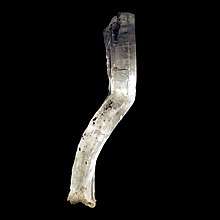
Gypsum is moderately water-soluble (~2.0–2.5 g/l at 25 °C)[7] and, in contrast to most other salts, it exhibits retrograde solubility, becoming less soluble at higher temperatures. When gypsum is heated in air it loses water and converts first to calcium sulfate hemihydrate, (bassanite, often simply called "plaster") and, if heated further, to anhydrous calcium sulfate (anhydrite). As for anhydrite, its solubility in saline solutions and in brines is also strongly dependent on NaCl (common table salt) concentration.[7]
Gypsum crystals are found to contain anion water and hydrogen bonding.[8]
Crystal varieties
Gypsum occurs in nature as flattened and often twinned crystals, and transparent, cleavable masses called selenite. Selenite contains no significant selenium; rather, both substances were named for the ancient Greek word for the Moon.
Selenite may also occur in a silky, fibrous form, in which case it is commonly called "satin spar". Finally, it may also be granular or quite compact. In hand-sized samples, it can be anywhere from transparent to opaque. A very fine-grained white or lightly tinted variety of gypsum, called alabaster, is prized for ornamental work of various sorts. In arid areas, gypsum can occur in a flower-like form, typically opaque, with embedded sand grains called desert rose. It also forms some of the largest crystals found in nature, up to 12 m (39 ft) long, in the form of selenite.[9]
Occurrence
Gypsum is a common mineral, with thick and extensive evaporite beds in association with sedimentary rocks. Deposits are known to occur in strata from as far back as the Archaean eon.[10] Gypsum is deposited from lake and sea water, as well as in hot springs, from volcanic vapors, and sulfate solutions in veins. Hydrothermal anhydrite in veins is commonly hydrated to gypsum by groundwater in near-surface exposures. It is often associated with the minerals halite and sulfur. Gypsum is the most common sulfate mineral.[11] Pure gypsum is white, but other substances found as impurities may give a wide range of colors to local deposits.
Because gypsum dissolves over time in water, gypsum is rarely found in the form of sand. However, the unique conditions of the White Sands National Park in the US state of New Mexico have created a 710 km2 (270 sq mi) expanse of white gypsum sand, enough to supply the US construction industry with drywall for 1,000 years.[12] Commercial exploitation of the area, strongly opposed by area residents, was permanently prevented in 1933 when President Herbert Hoover declared the gypsum dunes a protected national monument.
Gypsum is also formed as a by-product of sulfide oxidation, amongst others by pyrite oxidation, when the sulfuric acid generated reacts with calcium carbonate. Its presence indicates oxidizing conditions. Under reducing conditions, the sulfates it contains can be reduced back to sulfide by sulfate-reducing bacteria. Electric power stations burning coal with flue gas desulfurization produce large quantities of gypsum as a byproduct from the scrubbers.
Orbital pictures from the Mars Reconnaissance Orbiter (MRO) have indicated the existence of gypsum dunes in the northern polar region of Mars,[13] which were later confirmed at ground level by the Mars Exploration Rover (MER) Opportunity.[14]
- Crystals in the Cave of the Crystals in Mexico. Note person (lower right) for scale.
 Crystals that formed as the water evaporated in Lake Lucero, White Sands National Park.
Crystals that formed as the water evaporated in Lake Lucero, White Sands National Park.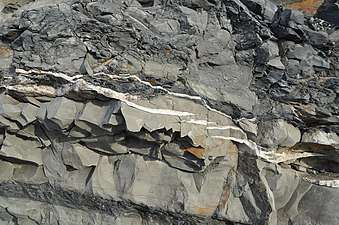 Veins in the silts/marls of the Tea Green and Grey Marls, Blue Anchor, Somerset, United Kingdom.
Veins in the silts/marls of the Tea Green and Grey Marls, Blue Anchor, Somerset, United Kingdom.- Veins in Caprock Canyons State Park and Trailway, Texas.
Mining
| Country | Production | Reserves |
|---|---|---|
| China | 132,000 | N/A |
| Iran | 22,000 | 1,600 |
| Thailand | 12,500 | N/A |
| United States | 11,500 | 700,000 |
| Turkey | 10,000 | N/A |
| Spain | 6,400 | N/A |
| Mexico | 5,300 | N/A |
| Japan | 5,000 | N/A |
| Russia | 4,500 | N/A |
| Italy | 4,100 | N/A |
| India | 3,500 | 39,000 |
| Australia | 3,500 | N/A |
| Oman | 3,500 | N/A |
| Brazil | 3,300 | 290,000 |
| France | 3,300 | N/A |
| Canada | 2,700 | 450,000 |
| Saudi Arabia | 2,400 | N/A |
| Algeria | 2,200 | N/A |
| Germany | 1,800 | 450,000 |
| Argentina | 1,400 | N/A |
| Pakistan | 1,300 | N/A |
| United Kingdom | 1,200 | 55,000 |
| Other countries | 15,000 | N/A |
| World total | 258,000 | N/A |
Commercial quantities of gypsum are found in the cities of Araripina and Grajaú in Brazil; in Pakistan, Jamaica, Iran (world's second largest producer), Thailand, Spain (the main producer in Europe), Germany, Italy, England, Ireland and Canada[16] and the United States. Large open pit quarries are located in many places including Fort Dodge, Iowa, which sits on one of the largest deposits of gypsum in the world,[17] and Plaster City, California, United States, and East Kutai, Kalimantan, Indonesia. Several small mines also exist in places such as Kalannie in Western Australia, where gypsum is sold to private buyers for additions of calcium and sulfur as well as reduction of aluminum toxicities on soil for agricultural purposes.
Crystals of gypsum up to 11 m (36 ft) long have been found in the caves of the Naica Mine of Chihuahua, Mexico. The crystals thrived in the cave's extremely rare and stable natural environment. Temperatures stayed at 58 °C (136 °F), and the cave was filled with mineral-rich water that drove the crystals' growth. The largest of those crystals weighs 55 tonnes (61 short tons) and is around 500,000 years old.[18]
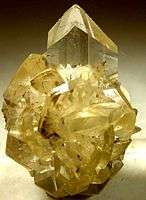 Golden gypsum crystals from Winnipeg
Golden gypsum crystals from Winnipeg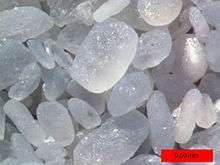
Synthesis
Synthetic gypsum is recovered via flue-gas desulfurization at some coal-fired power plants. It can be used interchangeably with natural gypsum in some applications.
Gypsum also precipitates onto brackish water membranes, a phenomenon known as mineral salt scaling, such as during brackish water desalination of water with high concentrations of calcium and sulfate. Scaling decreases membrane life and productivity. This is one of the main obstacles in brackish water membrane desalination processes, such as reverse osmosis or nanofiltration. Other forms of scaling, such as calcite scaling, depending on the water source, can also be important considerations in distillation, as well as in heat exchangers, where either the salt solubility or concentration can change rapidly.
A new study has suggested that the formation of gypsum starts as tiny crystals of a mineral called bassanite (CaSO4·1⁄2H2O).[19] This process occurs via a three-stage pathway:
- homogeneous nucleation of nanocrystalline bassanite;
- self-assembly of bassanite into aggregates, and
- transformation of bassanite into gypsum.
Occupational safety
People can be exposed to gypsum in the workplace by breathing it in, skin contact, and eye contact.
United States
The Occupational Safety and Health Administration (OSHA) has set the legal limit (permissible exposure limit) for gypsum exposure in the workplace as TWA 15 mg/m3 for total exposure and TWA 5 mg/m3 for respiratory exposure over an 8-hour workday. The National Institute for Occupational Safety and Health (NIOSH) has set a recommended exposure limit (REL) of TWA 10 mg/m3 for total exposure and TWA 5 mg/m3 for respiratory exposure over an 8-hour workday.[20]
Uses
.jpg)
Gypsum is used in a wide variety of applications:
- Gypsum board[21] is primarily used as a finish for walls and ceilings, and is known in construction as drywall, wallboard, sheetrock or plasterboard.
- Gypsum blocks are used like concrete blocks in building construction.
- Gypsum mortar is an ancient mortar used in building construction.
- Plaster ingredients are used in surgical splints, casting moulds and modeling.
- Fertilizer and soil conditioner: In the late 18th and early 19th centuries, Nova Scotia gypsum, often referred to as plaster, was a highly sought fertilizer for wheat fields in the United States. It is also used in ameliorating high-sodium soils,[22] such as in the Zuiderzee Works.[23]
- A binder in fast-dry tennis court clay
- As alabaster, a material for sculpture, it was used especially in the ancient world before steel was developed, when its relative softness made it much easier to carve.
- A wood substitute in the ancient world: For example, when wood became scarce due to deforestation on Bronze Age Crete, gypsum was employed in building construction at locations where wood was previously used.[24]
- A tofu (soy bean curd) coagulant, making it ultimately a major source of dietary calcium, especially in Asian cultures which traditionally use few dairy products
- Adding hardness to water used for brewing[25]
- Used in baking as a dough conditioner, reducing stickiness, and as a baked-goods source of dietary calcium.[26] The primary component of mineral yeast food.[27]
- A component of Portland cement used to prevent flash setting of concrete
- Soil/water potential monitoring (soil moisture)
- A common ingredient in making mead
- In the medieval period, scribes and illuminators mixed it with lead carbonate (powdered white lead) to make gesso, which was applied to illuminated letters and gilded with gold in illuminated manuscripts.
- In foot creams, shampoos and many other hair products
- A medicinal agent in traditional Chinese medicine called shi gao
- Impression plasters in dentistry
- Used in mushroom cultivation to stop grains from clumping together
- Tests have shown that gypsum can be used to remove pollutants such as lead[28] or arsenic[29][30] from contaminated waters.
Gallery
- Unusual gypsum specimens from around the world
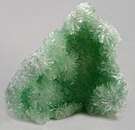 Green gypsum crystals from Pernatty Lagoon, Mt Gunson, South Australia - its green color is due to presence of copper ions.
Green gypsum crystals from Pernatty Lagoon, Mt Gunson, South Australia - its green color is due to presence of copper ions. Unusual selenite gypsum from the Red River, Winnipeg, Manitoba, Canada
Unusual selenite gypsum from the Red River, Winnipeg, Manitoba, Canada Classic "ram's horn" gypsum from Santa Eulalia, Chihuahua, Mexico, 7.5×4.3×3.8 cm
Classic "ram's horn" gypsum from Santa Eulalia, Chihuahua, Mexico, 7.5×4.3×3.8 cm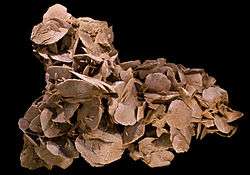 Desert rose, 47 cm long
Desert rose, 47 cm long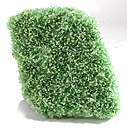 Gypsum from Pernatty Lagoon, Mt Gunson, Stuart Shelf area, Andamooka Ranges - Lake Torrens area, South Australia, Australia
Gypsum from Pernatty Lagoon, Mt Gunson, Stuart Shelf area, Andamooka Ranges - Lake Torrens area, South Australia, Australia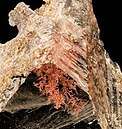 Gypsum with crystalline native copper inside
Gypsum with crystalline native copper inside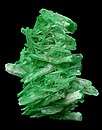 Gypsum from Swan Hill, Victoria, Australia. The colouring is due to the copper oxide
Gypsum from Swan Hill, Victoria, Australia. The colouring is due to the copper oxide Waterclear twined crystal of the form known as "Roman sword". Fuentes de Ebro, Zaragoza (Spain)
Waterclear twined crystal of the form known as "Roman sword". Fuentes de Ebro, Zaragoza (Spain)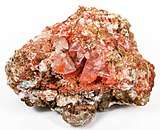 Bright, cherry-red gypsum crystals 2.5 cm in height colored by rich inclusions of the rare mineral botryogen
Bright, cherry-red gypsum crystals 2.5 cm in height colored by rich inclusions of the rare mineral botryogen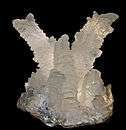 Gypsum from Naica, Mun. de Saucillo, Chihuahua, Mexico
Gypsum from Naica, Mun. de Saucillo, Chihuahua, Mexico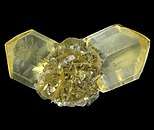 Golden color gem, "fishtail"-twinned crystals of gypsum sitting atop a "ball" of gypsum which is composed of several single bladed crystals
Golden color gem, "fishtail"-twinned crystals of gypsum sitting atop a "ball" of gypsum which is composed of several single bladed crystals
See also
- Gypcrust
- Gypsum flora of Nova Scotia
- Gypsum recycling
- Phosphogypsum
References
- Anthony, John W.; Bideaux, Richard A.; Bladh, Kenneth W.; Nichols, Monte C., eds. (2003). "Gypsum" (PDF). Handbook of Mineralogy. V (Borates, Carbonates, Sulfates). Chantilly, VA, US: Mineralogical Society of America. ISBN 978-0962209703.
- Gypsum. Mindat
- Klein, Cornelis; Hurlbut, Cornelius S., Jr. (1985), Manual of Mineralogy (20th ed.), John Wiley, pp. 352–353, ISBN 978-0-471-80580-9
- "Compact Oxford English Dictionary: gypsum".
- See:
- Thaer, Albrecht Daniel; Shaw, William, trans.; Johnson, Cuthbert W., trans. (1844). The Principles of Agriculture. vol. 1. London, England: Ridgway. pp. 519–520.
- Klaus Herrmann (1990), "Mayer, Johann Friedrich", Neue Deutsche Biographie (NDB) (in German), 16, Berlin: Duncker & Humblot, pp. 544–545; (full text online) From p. 544: " … er bewirtschaftete nebenbei ein Pfarrgüttchen, … für die Düngung der Felder mit dem in den nahen Waldenburger Bergen gefundenen Gips einsetzte." ( … he also managed a small parson's estate, on which he repeatedly conducted agricultural experiments. In 1768, he first published the fruits of his experiences during this time as "Instruction about Gypsum", in which he espoused the fertilizing of fields with the gypsum that was found in the nearby Waldenburg mountains.)
- Beckmann, Johann (1775). Grundsätze der deutschen Landwirthschaft [Fundamentals of German Agriculture] (in German) (2nd ed.). Göttingen, (Germany): Johann Christian Dieterich. p. 60. From p. 60: "Schon seit undenklichen Zeiten … ein Gewinn zu erhalten seyn wird." (Since times immemorial, in our vicinity, in the ministry of Niedeck [a village southeast of Göttingen], one has already made this use of gypsum; but Mr. Mayer has the merit to have made it generally known. In the History of Farming in Kupferzell, he had depicted a crushing mill (p. 74), in order to pulverize gypsum, from which a profit has been obtained, albeit with difficulty.)
- Mayer, Johann Friderich (1768). Lehre vom Gyps als vorzueglich guten Dung zu allen Erd-Gewaechsen auf Aeckern und Wiesen, Hopfen- und Weinbergen [Instruction in gypsum as an ideal good manure for all things grown in soil on fields and pastures, hops yards and vineyards] (in German). Anspach, (Germany): Jacob Christoph Posch.
- Smith, Joshua (2007). Borderland smuggling: Patriots, loyalists, and illicit trade in the Northeast, 1780–1820. Gainesville, FL: UPF. pp. passim. ISBN 978-0-8130-2986-3.
- Bock, E. (1961). "On the solubility of anhydrous calcium sulphate and of gypsum in concentrated solutions of sodium chloride at 25 °C, 30 °C, 40 °C, and 50 °C". Canadian Journal of Chemistry. 39 (9): 1746–1751. doi:10.1139/v61-228.
- Mandal, Pradip K; Mandal, Tanuj K (2002). "Anion water in gypsum (CaSO4·2H2O) and hemihydrate (CaSO4·1/2H2O)". Cement and Concrete Research. 32 (2): 313. doi:10.1016/S0008-8846(01)00675-5.
- García-Ruiz, Juan Manuel; Villasuso, Roberto; Ayora, Carlos; Canals, Angels; Otálora, Fermín (2007). "Formation of natural gypsum megacrystals in Naica, Mexico" (PDF). Geology. 35 (4): 327–330. Bibcode:2007Geo....35..327G. doi:10.1130/G23393A.1. hdl:10261/3439.
- Cockell, C. S.; Raven, J. A. (2007). "Ozone and life on the Archaean Earth". Philosophical Transactions of the Royal Society A. 365 (1856): 1889–1901. Bibcode:2007RSPTA.365.1889C. doi:10.1098/rsta.2007.2049. PMID 17513273.
- Deer, W.A.; Howie, R.A.; Zussman, J. (1966). An Introduction to the Rock Forming Minerals. London: Longman. p. 469. ISBN 978-0-582-44210-8.
- Abarr, James (7 February 1999). "Sea of sand". The Albuquerque Journal. Archived from the original on 30 June 2006. Retrieved 27 January 2007.
- High-resolution Mars image gallery. University of Arizona
- NASA Mars Rover Finds Mineral Vein Deposited by Water, NASA, 7 December 2011.
- "GYPSUM" (PDF). U.S. Geological Survey.
- "Mines, mills and concentrators in Canada". Natural Resources Canada. 24 October 2005. Archived from the original on 13 March 2005. Retrieved 27 January 2007.
- The Hutchinson Unabridged Encyclopedia with Atlas and Weather Guide. Helion. 2018 – via Credo Reference.
- Alleyne, Richard (27 October 2008). "World's largest crystal discovered in Mexican cave". The Telegraph. London. Retrieved 6 June 2009.
- Van Driessche, A.E.S.; Benning, L. G.; Rodriguez-Blanco, J. D.; Ossorio, M.; Bots, P.; García-Ruiz, J. M. (2012). "The role and implications of bassanite as a stable precursor phase to gypsum precipitation". Science. 336 (6077): 69–72. Bibcode:2012Sci...336...69V. doi:10.1126/science.1215648. PMID 22491851.
- "CDC – NIOSH Pocket Guide to Chemical Hazards – Gypsum". www.cdc.gov. Retrieved 3 November 2015.
-
- Complimentary list of MasterFormat 2004 Edition numbers and titles (large PDF document)
- Oster, J. D.; Frenkel, H. (1980). "The chemistry of the reclamation of sodic soils with gypsum and lime". Soil Science Society of America Journal. 44 (1): 41–45. Bibcode:1980SSASJ..44...41O. doi:10.2136/sssaj1980.03615995004400010010x.
- Ley, Willy (October 1961). "The Home-Made Land". For Your Information. Galaxy Science Fiction. pp. 92–106.
- Hogan, C. Michael (2007). "Knossos fieldnotes". Modern Antiquarian.
- Palmer, John. "Water Chemistry Adjustment for Extract Brewing". HowToBrew.com. Retrieved 15 December 2008.
- "Calcium sulphate for the baking industry" (PDF). United States Gypsum Company. Archived from the original (PDF) on 4 July 2013. Retrieved 1 March 2013.
- "Tech sheet for yeast food" (PDF). Lesaffre Yeast Corporation. Archived from the original (PDF) on November 2014. Retrieved 1 March 2013.
- Astilleros, J.M.; Godelitsas, A.; Rodríguez-Blanco, J.D.; Fernández-Díaz, L.; Prieto, M.; Lagoyannis, A.; Harissopulos, S. (2010). "Interaction of gypsum with lead in aqueous solutions" (PDF). Applied Geochemistry. 25 (7): 1008. Bibcode:2010ApGC...25.1008A. doi:10.1016/j.apgeochem.2010.04.007.
- Rodriguez, J. D.; Jimenez, A.; Prieto, M.; Torre, L.; Garcia-Granda, S. (2008). "Interaction of gypsum with As(V)-bearing aqueous solutions: Surface precipitation of guerinite, sainfeldite, and Ca2NaH(AsO4)2⋅6H2O, a synthetic arsenate". American Mineralogist. 93 (5–6): 928. Bibcode:2008AmMin..93..928R. doi:10.2138/am.2008.2750.
- Rodríguez-Blanco, Juan Diego; Jiménez, Amalia; Prieto, Manuel (2007). "Oriented Overgrowth of Pharmacolite (CaHAsO4⋅2H2O) on Gypsum (CaSO4⋅2H2O)". Cryst. Growth Des. 7 (12): 2756–2763. doi:10.1021/cg070222+.
External links
| Wikimedia Commons has media related to Gypsum. |
| Look up gypsum in Wiktionary, the free dictionary. |
- WebMineral data
- Mineral galleries – gypsum
- CDC – NIOSH Pocket Guide to Chemical Hazards
- . Encyclopædia Britannica (11th ed.). 1911.
